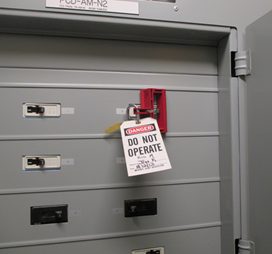A person can be seriously injured, even killed, when working on a machine or equipment if the hazardous energy sources are not controlled.
When performing maintenance, service or repair work on equipment, processes or systems, all hazardous energy sources must be controlled using lockout/tagout procedures and OSHA-approved locks and tags to protect those impacted from the unintended start-up or release of stored energy. Common hazardous energy sources include electrical, hydraulic, pneumatic, mechanical, thermal, chemical or gravitational.

How do I use lockout/tagout to control hazardous energy?
A foundational element of lockout/tagout is a specific hazardous energy control procedure for each machine or equipment that describes how to effectively de-energize or isolate and relieve any potential stored energy before performing work.
The Hazardous Energy Control - Lockout/Tagout webpage has two equipment-specific hazardous energy control procedure templates that can be used to document the sequential steps for controlling hazardous energy for a specific equipment or machine.
Which lockout/tagout procedure template should I use?
- For equipment that is routinely serviced and the procedure for de-energizing does not change, this lockout/tagout procedure template can be used and periodically reviewed for accuracy.
- If the equipment or machine is part of a system and the scope of work changes frequently, the lockout/tagout template for the field is recommended and can be verified by a second person (reviewer).
When completed in its entirety, either template meets the required elements of hazardous energy control and the accompanying steps.
Who develops and maintains a lockout/tagout program?
The UW Hazardous Energy Control - Lockout/Tagout program applies to all UW staff, faculty and students involved in the maintenance, repair or service of equipment, processes and systems in their workplace, laboratory or shop location. The lockout/tagout program requires:
- A formal, written lockout/tagout program that defines the program’s requirements, and identifies specific activities where the use of lockout/tagout is required or exempted.
- Equipment-specific energy control procedures and annual inspection requirements.
- Equipment designed to accept OSHA-approved lockout/tagout devices and that these devices are readily available.
- Defined roles and responsibilities for implementing the lockout/tagout program.
- Training of personnel in the lockout/tagout program.
- Enforcement of the program to ensure hazardous energy is controlled during work.
Please contact Environmental Health & Safety at ehsdept@uw.edu if you need assistance of have questions on how to comply with the UW Hazardous Energy Control - Lockout/Tagout program requirements.